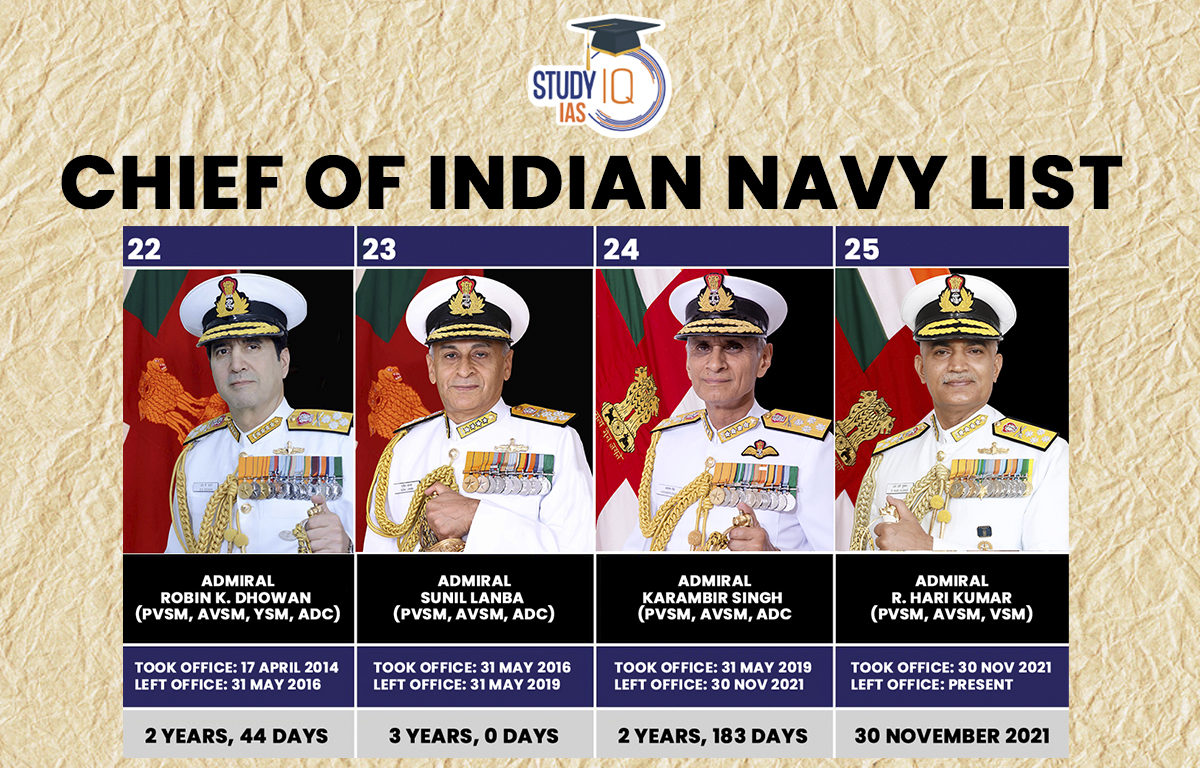Table of Contents
Chief of Indian Navy
The Indian Navy is led by the Chief of Naval Staff of India. Except when the Chief of Defence is a navy officer, he is the highest-ranking naval officer on active duty in the Indian Armed Forces (IAF). Since 1966, the position of Chief of Naval Staff (CNS) has always been held by a full Admiral. The 25th Chief of Indian Navy is Admiral R Hari Singh. On November 30, 2021, he succeeded Admiral Karambir Singh after four decades of service in the Indian Navy.
The topic of Indian Navy Admirals is crucial for competitive examinations. The subject is covered in general awareness parts for a variety of government exams, including SSC, RRB, Bank, Defence etc. Moreover, the UPSC prelims will likely have one or two questions about the Chief of the Indian Navy. This article will include a List of Indian Navy Admirals who held the position of Chief of Indian Navy Staff from 1947 to 2023.
List of Chief of Indian Navy Admirals From 1947 to 2023
The Indian Navy’s highest-ranked officer, known as the captain or CNS, is known as the Chief of the Naval Staff. The list of Indian Navy admirals and the length of their service as Chief of Indian Navy is provided below:
| List of Indian Navy Admirals – Chief of Navy Staff | |
| Names of CNS | Tenure of Office |
| Rear Admiral J.T.S. Hall | August 15, 1947, to August 14 1948 |
| Admiral Sir Edward Parry | August 15, 1948, to October 13 1951 |
| Admiral Sir Mark Pizey | October 14, 1951, to 21 July 1955 |
| Vice-Admiral Sir Stephen Carlill | 22 July 1955 to April 21 1958 |
| Vice-Admiral R.D. Katari | April 22, 1958, to June 4 1962 |
| Vice Admiral B.S. Soman | June 05, 1962, to March 3 1966 |
| Admiral A.K. Chatterjee | March 04, 1966, to February 27 1970 |
| Admiral S.M. Nanda | February 28, 1970, to February 28 1973 |
| Admiral S.N. Kohli | March 01, 1973, to February 28 1976 |
| Admiral J.L. Cursetji | March 01, 1976, to February 28 1979 |
| Admiral R.L. Pereira | March 01, 1979, to February 28 1982 |
| Admiral O.S. Dawson | March 01, 1982, to November 30 1984 |
| Admiral R.H. Tahiliani | December 01, 1984, to November 30 1987 |
| Admiral J.G. Nadkarni | December 01, 1987, to November 30 1990 |
| Admiral Ramdas | December 01, 1990, to September 30 1993 |
| Admiral V.S. Shekhawat | October 01, 1993, to September 30 1996 |
| Admiral Vishnu Bhagwat | October 01, 1996, to December 30 1998 |
| Admiral Sushil Kumar | December 31, 1998, to December 29 2001 |
| Admiral Madhvendra Singh | December 29, 2001, to July 31 2004 |
| Admiral Arun Prakash | August 01, 2004, to October 30 2006 |
| Admiral Suresh Mehta | October 30, 2006, to August 31 2009 |
| Admiral Nirmal Verma | August 31, 2009, to August 31 August 2012 |
| Admiral Devender Kumar Joshi | August 31, 2012, to February 26 2014 |
| Vice Admiral RK Dhowan | February 26, 2014, to May 31 2016 |
| Admiral Sunil Lanba | May 31, 2016, to May 31 2019 |
| Admiral Karambir Singh | May 31, 2019, to November 30th, 2021 |
| Admiral Hari Singh | November 30th, 2021 to Present |
Indian Navy Admirals
The Indian Navy’s four-star flag officer rank of admiral. In the Indian Navy, it is the highest active rank. The five-star position of admiral of the fleet, which has never been granted or held, is above the three-star rank of vice admiral and below the rank of admiral. To distinguish them from lower flag officers levels like a vice admiral and rear admiral, admirals are sometimes referred to as full admirals or four-star admirals.
The Chief of the Naval Staff (CNS), the official commander of the Indian Navy, has held the position since 1968. If the bearer is an active Indian Navy flag officer, the Chief of Defence Staff (CDS) may also hold the rank. The first Indian officer to hold the position of full admiral was Adhar Kumar Chatterji. Admiral R. Hari Kumar is the only full admiral in the Indian Armed Forces and the current Chief of the Naval Staff (CNS). General and air chief marshal are the corresponding ranks in the Indian Army and Air Force, respectively.
Important Information about Indian Navy Admirals
- At the time of independence, the Navy’s commander was known as the Commander-in-Chief of, Royal Indian Navy.
- On March 1, 1948, the title “Chief of the Naval Staff and Commander-in-Chief of the Royal Indian Navy” was added.
- The “Royal” designation was dropped when India became a republic on January 26, 1950. Thus designating the Indian Navy head to “Chief of the Naval Staff and Commander-in-Chief, Indian Navy”.
- The Commanders-in-Chief (Change in Designation) Act of 1955 renamed the Indian Navy’s Chief of Naval Staff.
- The position of CNS is held by both a three-star Vice Admiral and a two-star Rear Admiral. However, the Chief of Naval Staff has always been a full Admiral since 1966. The Appointments Committee of the Cabinet (ACC) appoints CNS to the position.
- The CNS typically reaches superannuation after three years of service or at the age of 62, whichever comes first.
Facts about the Indian Navy
- The Indian Navy is currently the world’s seventh-strongest maritime force, trailing only the United States, Russia, China, Japan, the United Kingdom, and France. As of June 2019, the force had 150 submarines and ships, 300 aircraft, and 67,252 active and 55,000 reserve personnel.
- The anti-ship cruise missile BrahMos of the Indian Navy is the world’s fastest operational system in its class. The range of the missile system has recently been increased from 298 km to nearly 450 km by the Defence Research and Development Organisation (DRDO).
- The Indian Navy’s special operations unit, MARCOS (originally called Marine Commando Force), was established in 1987 and is trained and equipped to conduct operations at sea, on land, and in the air.
- The force has received international acclaim for its professionalism.
The Indian Navy’s ‘Sagar Pawan,’ founded in 2003, is one of the world’s only two naval aerobatic teams, the other being the US Navy’s Blue Angels. - The Indian Navy’s first independent operation occurred in 1961 when it successfully fought against the Portuguese navy during the liberation of Goa.


 Daily Quiz 14 April 2025
Daily Quiz 14 April 2025
 UPSC Syllabus 2025, Check UPSC CSE Sylla...
UPSC Syllabus 2025, Check UPSC CSE Sylla...
 EU Plans to Slash General Data Protectio...
EU Plans to Slash General Data Protectio...





















